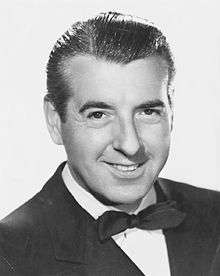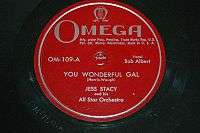Jess Stacy
| Jess Stacy | |
|---|---|
 Jess Stacy, c. 1945 | |
| Background information | |
| Birth name | Jesse Alexandria Stacy |
| Born |
August 11, 1904 Bird's Point, Missouri, U.S. |
| Origin | Cape Girardeau, Missouri, U.S. |
| Died |
January 1, 1995 (aged 90) Los Angeles, California, U.S. |
| Genres | Jazz |
| Occupation(s) | Musician |
| Instruments | Piano |
| Associated acts | Earl Hines, Bob Crosby, Tommy Dorsey, Benny Goodman, Lee Wiley |
Jesse Alexandria Stacy (August 11, 1904 – January 1, 1995) was an American jazz pianist who gained prominence during the swing era. He is perhaps best known for his years with the Benny Goodman band during the late 1930s, particularly his performance at Goodman's Carnegie Hall concert in 1938.
Early life
Stacy was born in Bird's Point, Missouri, a small town across the Mississippi River from Cairo, Illinois. His first piano teacher was Mabel Irene Bailey who played piano for the silent movies. In 1918 Stacy moved to Cape Girardeau, Missouri. There Stacy received his only formal music training studying under Professor Clyde Brandt, a professor of piano and violin at Southeast Missouri State Teachers College (now Southeast Missouri State University),[1] while sweeping up nights at Clark's Music Store.[2]
By 1920 Stacy was playing piano in saxophonist Peg Meyer's jazz ensemble at Cape Girardeau High School and at the Bluebird Confectionary on Broadway and Fountain and also at the Sweet Shop on Main Street. Originally labeled by schoolmates as "The Agony Four",[3] "that band took them out of Cape Girardeau where, according to Stacy, 'everyone was square as a bear'".[4] By 1921, the ensemble was known as Peg Meyer's Melody Kings and started touring the Mississippi River on Majestic and other riverboats.[5]
Career
Early career

At some unknown date in the early 1920s Stacy moved 'upriver' to Chicago, Illinois, where he received notice performing with Paul Mares, leader of the New Orleans Rhythm Kings, playing a genre of jazz which came to be called "Chicago-style". Stacy cites his main influences at the time as Louis Armstrong and, especially, pianist Earl Hines, pianist for both Armstrong and the Carroll Dickerson band.[1] Stacy would frequently go to wherever Hines was playing and later played with Hines' band as 'relief piano player' in The Grand Terrace Cafe [as did Nat "King" Cole and Teddy Wilson] but during this time Stacy was mostly playing with Floyd Towne’s dance orchestra.

Stacy's big break came in 1935 when Benny Goodman asked Stacy to join his band. Stacy left Floyd Towne, moved to New York, and spent 1935-39 with the Benny Goodman Orchestra. He reached a personal peak when he performed with Goodman band at its famous 1938 Carnegie Hall jazz concert on 16 January 1938,[1] the first jazz concert ever played at the venue.
The Carnegie Hall performance was elevated in part by Stacy's unplanned piano solo during "Sing, Sing, Sing (With a Swing)", around which a great modern legacy has grown. Following a Goodman/Krupa duet, Stacy received a nod from Goodman to take a solo. "At the Carnegie Hall concert, after the usual theatrics, Jess Stacy was allowed to solo and, given the venue, what followed was appropriate ... Used to just playing rhythm on the tune, he was unprepared for a turn in the spotlight, but what came out of his fingers was a graceful, impressionistic marvel with classical flourishes, yet still managed to swing. It was the best thing he ever did, and it's ironic that such a layered, nuanced performance came at the end of such a chaotic, bombastic tune", wrote David Rickert.[6]
A 1939 review of 'Jess Stacy' (Commodore 1503) stated:
"These two five-minute blues are probably the finest solos ever recorded by Jess Stacy and the best coupling ever issued by Milt Gabler on his Commodore label. When this most sensitive, intelligent and polished of piano players goes to work in the simple, traditional blues form, the result is likely to be more individual than authentic; and that was the case here. On the slow blues, "EcStacy", and a faster one named "The Sell Out", Stacy has lavished all his musical sincerity, his harmonic invention and delicate melodic ideas, all performed with uniquely fine touch and really incisive phrasing. "EcStacy" is quiet, and the chords ring out like chimes; in "The Sell Out", Stacy's foot acts as bass drum and the swing is very easy and sure. Instead of the sterility which afflicts so many of the "advanced" jazz players, there is the sincere, personal emotion, and integrity, of a uniquely talented musician. Much intellect went into this music, and in places you can almost hear Jess' rapid thinking".[7]
After leaving the Goodman Orchestra, Stacy joined the Bob Crosby Orchestra and his famous small jazz group the Bob Crosby Bob-Cats. During his period with the latter band Stacy received yet wider acclaim. He won the national Down Beat piano polls in 1940,[8] 1941, 1942, and 1943.[9]
Later career
In 1950 Stacy moved to Los Angeles, California.[10] As with many jazz 'stars', his career declined to mostly club work. Finally one evening, while working the piano bar in Leon's Steak House, Stacy walked out in the middle of a number after a drunken woman, while requesting the "Beer Barrel Polka" for the third time that evening, spilled a beer in his lap. Stacy declared that he was 'done' with the music business and retired from public performances.[11] He subsequently worked as a salesman, warehouseman, postman, and for Max Factor cosmetics before being rediscovered as the fame of his past career became known. However Stacy was selective in his performances – he played for Nelson Riddle on the soundtrack of The Great Gatsby (1974). The same year as the film's release he was invited to play at the Newport Jazz Festival in New York and, as a result, was asked to record twice for the Chiaroscuro label, in 1974, and, in 1977, Stacy Still Swings.
The years after that included compilations and some club work. Stacy’s final performance was broadcast on Marian McPartland's Piano Jazz for National Public Radio on December 1, 1981.[12] After his brief and 'selective' revival in the 1970s, Stacy again retired from the music scene and lived a quiet existence with his third wife, Patricia Peck Stacy.[13]
In addition to the Goodman and Bob Crosby orchestras Stacy played with Bix Beiderbecke, Eddie Condon, Bud Freeman, George Gershwin, Lionel Hampton, Billie Holiday, Gene Krupa, Jack Teagarden and, later, Horace Heidt.
Personal life
Stacy had a tumultuous love life as a young man. His first wife was Helen Robinson. Both were very young when they married in 1924. Stacy worked nights playing in clubs and slept during the day while Robinson worked days. She needed more security than Stacy was willing to provide, and Stacy was unwilling to work at a radio station in secure employment. This did not change when the couple had a child, Frederick Jess. The couple would later divorce and Robinson would go on to marry a friend of Stacy's, saxophonist Phil Wing, the embodiment of all she had wanted Stacy to be.[14]
Stacy's second wife was the beautiful and wild Lee Wiley, a jazz singer of considerable acclaim at the time and subsequently. The couple was described by their friend Deane Kincaide as being as "compatible as two cats, tails tied together, hanging over a clothesline."[15]
After being married less than three years, the couple divorced in 1948. Lee's response to Stacy's desire to get a divorce was, "What will Bing Crosby be thinking of you divorcing me?"[15] while Stacy said of Wiley, "They did not burn the last witch at Salem." Wiley remarried retired business man, Nat Tischenkel in 1966.
Stacy's third wife was Patricia Peck. They had been friends and dating for a decade when they married on September 8, 1950. Stacy and Peck lived in Los Angeles and were married for forty-five years.
Stacy died of congestive heart failure in Los Angeles, California on January 1, 1995.
Legacy
Stacy was inducted into the Big Band and Jazz Hall of Fame in 1996, and his life story, Jess Stacy: The Quiet Man of Jazz. a Biography and Discography, was published in 1998.[15]
Discography
With Benny Goodman
- The Complete RCA Victor Small Group Recordings (RCA Victor, 1935-39 [1997])
Solo Piano
Piano Moods (Columbia CL 6147) [1950] Ten Inch
- Ralph Sutton & Jess Stacy - Piano Solos (Ace of Hearts Records AH 39 (Decca), [c1953])
- Stacy Still Swings (Chiaroscuro [1974])
References
- 1 2 3 Allen, Steve. "The Return of Jess Stacy", unknown newspaper, undated. Jess Stacy Collection, Box 1036, Folder 7, Item B, Special Collections and Archives, Kent Library, Southeast Missouri State University. but see 'Discussion'
- ↑ "Classic Jazz A personal view of the Music and Musicians: Floyd Evans and Benny Carter", pg. 136, University of California Press 2002; ISBN 978-0-520-23463-5
- ↑ Kenney, W.H. Jazz on the River. (Chicago: University of Chicago Press, 2005.) 136.
- ↑ W.H. Kenney Jazz on the River, University of Chicago Press 2005, pg. 136
- ↑ Special Collections and Archives, Southeast Missouri State University, Jess Stacy Collection Finding Aid, Descriptive Overview.
- ↑ David Rickert (January 31, 2005). "Benny Goodman: "Sing, Sing, Sing"". Retrieved August 7, 2018.
- ↑ The Weekly Magazine: Nov 7 1939: EcStacy/The Sell Out: Piano Solo 12 inches.
- ↑ Levin, Floyd. Classic Jazz: A Personal View of the Music and the Musicians (Berkeley: University of California Press, 2000), pg. 137
- ↑ "Photograph, Jess Stacy, Dorothy Lamour and Bob Crosby, presenting Stacy with "Best Pianist of the Year" award, undated. Published in Downbeat. Jess Stacy Collection, Box 1036, Folder 2, Item B, Special Collections and Archives, Kent Library, Southeast Missouri State University.
Library.semo.edu - ↑ "He's Come a Long Way from St. Louis", The San Francisco Chronicle, November 20, 1950. Jess Stacy Collection, Box 1036, Folder 7, Item G, Special Collections and Archives, Kent Library, Southeast Missouri State University Library.semo.edu
- ↑ Levin, pg. 138.
- ↑ "Jazz Rambler": San Diego November/December 2004 No 6
- ↑ Levin, pg. 139.
- ↑ Keller, Keith. Oh, Jess: A Jazz Life. The Mayan Music Corporation, 1989. ISBN 978-87-88043-08-2
- 1 2 3 Derek Coller: G H B Jazz Foundation; ISBN 978-0-9638890-4-1, pg. 113
Further reading
- Meyer, Raymond F. “Peg”. Backwoods Jazz in the Twenties. Edited and with an introduction by Frank Nickell. Published by Center for Regional History and Cultural Heritage Southeast Missouri State University, Cape Girardeau Missouri, c. 1989.
External Links
- Jess Stacy Interview NAMM Oral History Library (1987)